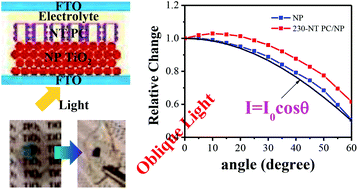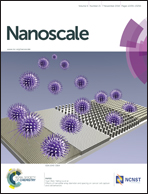A strategy to reduce the angular dependence of a dye-sensitized solar cell by coupling to a TiO2 nanotube photonic crystal†
Abstract
Almost all types of solar cells suffer from a decreased power output when the incident light is tilted away from normal since the incident intensity generally follows a cosine law of the incident angle. Making use of the blue shift nature of the Bragg position of a TiO2 nanotube photonic crystal (NT PC) under oblique incidence, we demonstrate experimentally that the use of the NT PC can partially compensate the cosine power loss of a dye-sensitized solar cell (DSSC). The strategy used here is to purposely choose the Bragg position of the NT PC to be at the longer wavelength side of the dye absorption peak. When the incident light is tilted, the blue shift of the Bragg position results in more overlap with the dye absorption peak, generating a higher efficiency that partially compensates the reduced photon flux due to light inclination. Moreover, the unique structure of the vertically aligned TiO2 nanotubes contributes an additional scattering effect when the incident light is tilted. As a result, the power output of a DSSC coupled with the NT PC layer shows a much flatter angular dependence than a DSSC without the NT PC. At all the incident angles, the DSSC coupled with the NT PC layer also shows a higher power conversion efficiency than the one without. The concept of using NT PC to mitigate the angular dependence of DSSCs can be easily extended to many other optoelectronic devices that are irradiance sensitive.


 Please wait while we load your content...
Please wait while we load your content...